HS4005 Essay: Critical Analysis of Dementia in Public Health
VerifiedAdded on 2022/09/13
|17
|4976
|13
Essay
AI Summary
This essay provides a comprehensive analysis of dementia as a significant public health issue, examining its prevalence, causes, and impact. The essay critically evaluates four peer-reviewed articles, focusing on various aspects of dementia research. The first article explores the use of machine learning to identify undiagnosed dementia cases in primary care settings. The second investigates the prevalence of dementia with Lewy bodies (DLB) and Parkinson's disease dementia (PDD) across different healthcare services. The third article presents a modeling study that forecasts the future prevalence and incidence of dementia in England and Wales, considering cardiovascular disease and mortality. The fourth article examines the determinants and prevalence of agitation among dementia residents in care homes. The essay also defines key terms such as case-control and cohort studies and confidence intervals. The essay employs various statistical methods, including logistic regression and random forest, to analyze the data. The findings highlight the importance of early diagnosis, the variability in dementia prevalence, and the impact of agitation on the quality of life for those affected. The essay concludes by emphasizing the need for further research and interventions to address the growing public health challenge of dementia.

Running head: ESSAY
HS4005 Statistics for Public Health
Name of the Student
Name of the University
Author Note
HS4005 Statistics for Public Health
Name of the Student
Name of the University
Author Note
Paraphrase This Document
Need a fresh take? Get an instant paraphrase of this document with our AI Paraphraser
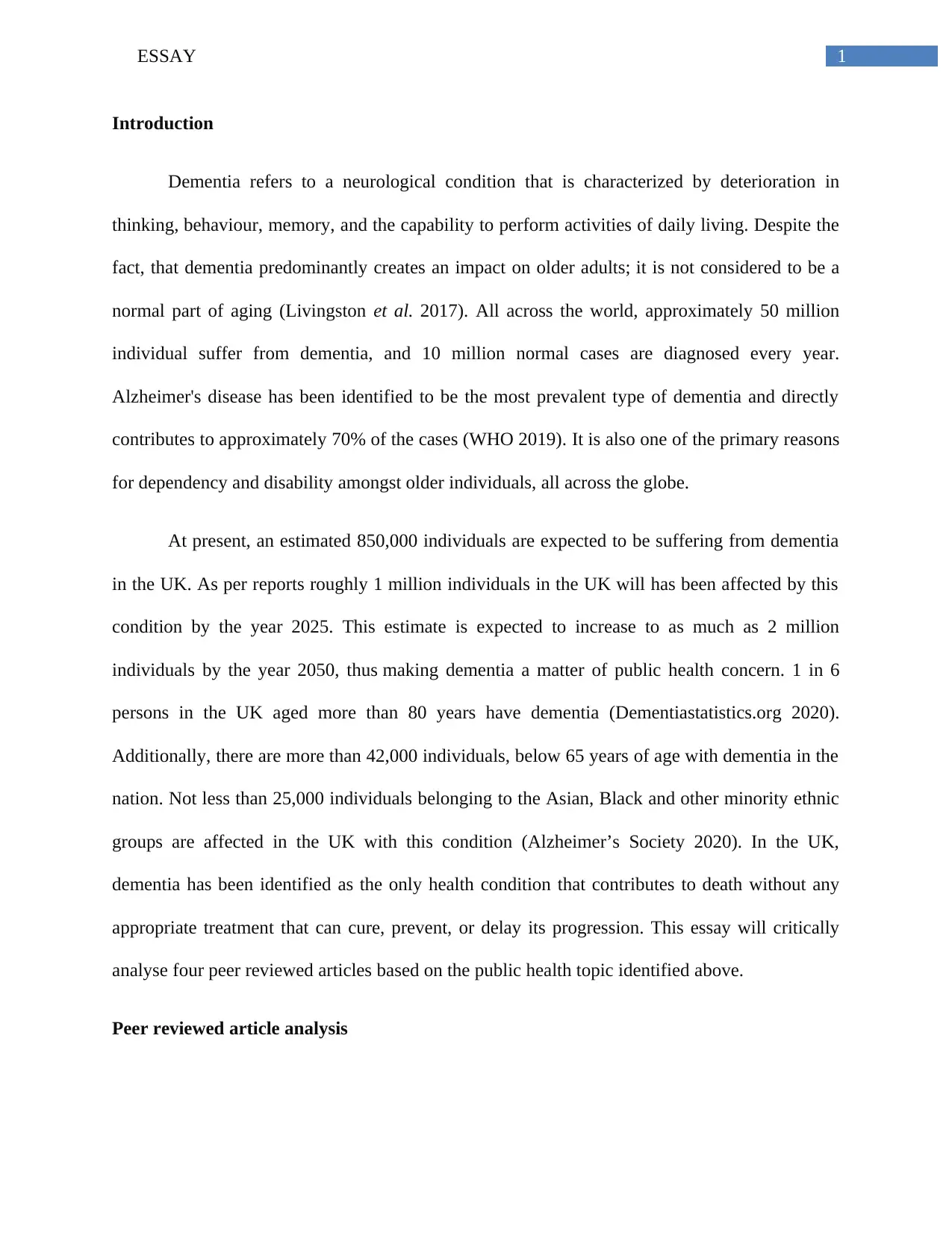
1ESSAY
Introduction
Dementia refers to a neurological condition that is characterized by deterioration in
thinking, behaviour, memory, and the capability to perform activities of daily living. Despite the
fact, that dementia predominantly creates an impact on older adults; it is not considered to be a
normal part of aging (Livingston et al. 2017). All across the world, approximately 50 million
individual suffer from dementia, and 10 million normal cases are diagnosed every year.
Alzheimer's disease has been identified to be the most prevalent type of dementia and directly
contributes to approximately 70% of the cases (WHO 2019). It is also one of the primary reasons
for dependency and disability amongst older individuals, all across the globe.
At present, an estimated 850,000 individuals are expected to be suffering from dementia
in the UK. As per reports roughly 1 million individuals in the UK will has been affected by this
condition by the year 2025. This estimate is expected to increase to as much as 2 million
individuals by the year 2050, thus making dementia a matter of public health concern. 1 in 6
persons in the UK aged more than 80 years have dementia (Dementiastatistics.org 2020).
Additionally, there are more than 42,000 individuals, below 65 years of age with dementia in the
nation. Not less than 25,000 individuals belonging to the Asian, Black and other minority ethnic
groups are affected in the UK with this condition (Alzheimer’s Society 2020). In the UK,
dementia has been identified as the only health condition that contributes to death without any
appropriate treatment that can cure, prevent, or delay its progression. This essay will critically
analyse four peer reviewed articles based on the public health topic identified above.
Peer reviewed article analysis
Introduction
Dementia refers to a neurological condition that is characterized by deterioration in
thinking, behaviour, memory, and the capability to perform activities of daily living. Despite the
fact, that dementia predominantly creates an impact on older adults; it is not considered to be a
normal part of aging (Livingston et al. 2017). All across the world, approximately 50 million
individual suffer from dementia, and 10 million normal cases are diagnosed every year.
Alzheimer's disease has been identified to be the most prevalent type of dementia and directly
contributes to approximately 70% of the cases (WHO 2019). It is also one of the primary reasons
for dependency and disability amongst older individuals, all across the globe.
At present, an estimated 850,000 individuals are expected to be suffering from dementia
in the UK. As per reports roughly 1 million individuals in the UK will has been affected by this
condition by the year 2025. This estimate is expected to increase to as much as 2 million
individuals by the year 2050, thus making dementia a matter of public health concern. 1 in 6
persons in the UK aged more than 80 years have dementia (Dementiastatistics.org 2020).
Additionally, there are more than 42,000 individuals, below 65 years of age with dementia in the
nation. Not less than 25,000 individuals belonging to the Asian, Black and other minority ethnic
groups are affected in the UK with this condition (Alzheimer’s Society 2020). In the UK,
dementia has been identified as the only health condition that contributes to death without any
appropriate treatment that can cure, prevent, or delay its progression. This essay will critically
analyse four peer reviewed articles based on the public health topic identified above.
Peer reviewed article analysis
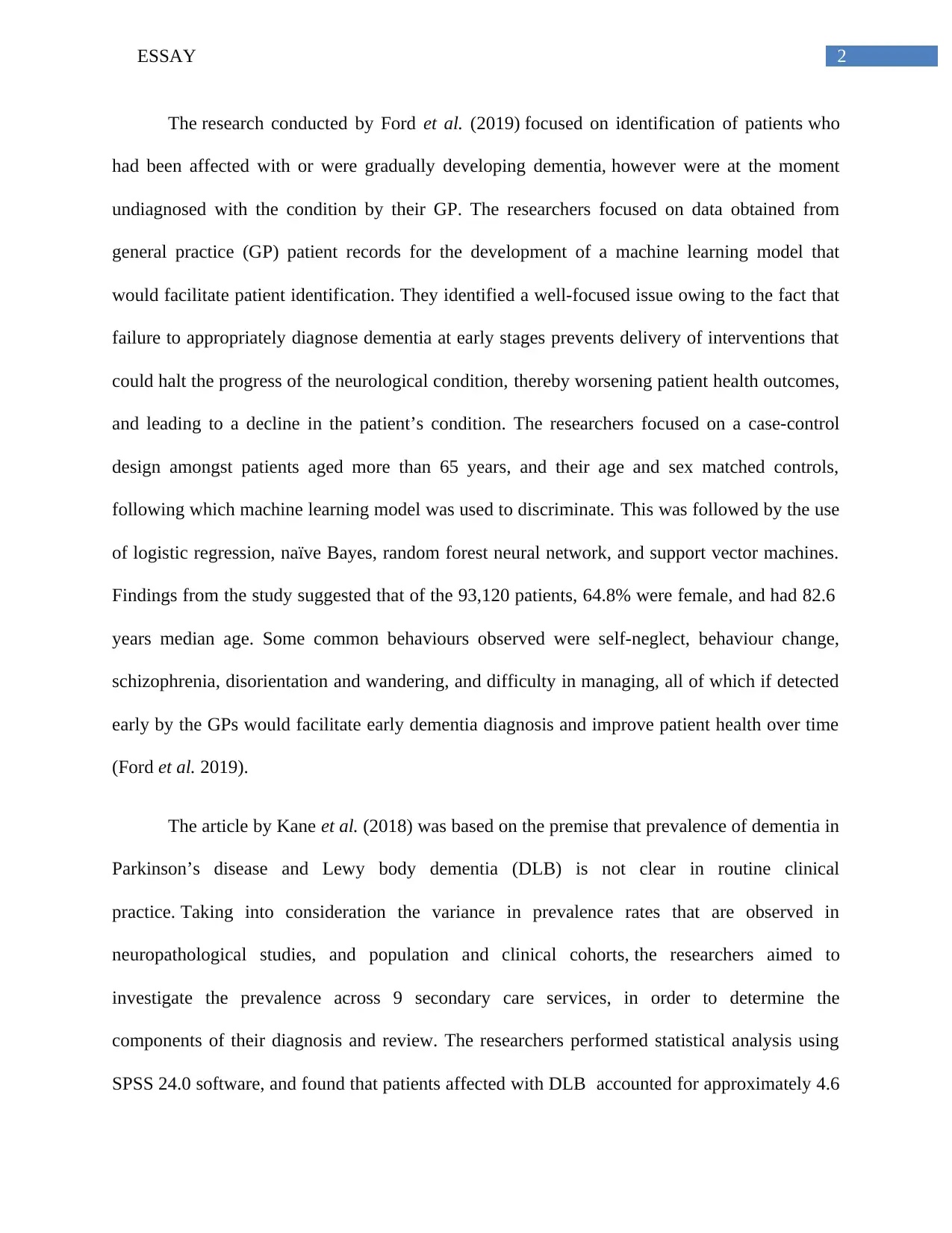
2ESSAY
The research conducted by Ford et al. (2019) focused on identification of patients who
had been affected with or were gradually developing dementia, however were at the moment
undiagnosed with the condition by their GP. The researchers focused on data obtained from
general practice (GP) patient records for the development of a machine learning model that
would facilitate patient identification. They identified a well-focused issue owing to the fact that
failure to appropriately diagnose dementia at early stages prevents delivery of interventions that
could halt the progress of the neurological condition, thereby worsening patient health outcomes,
and leading to a decline in the patient’s condition. The researchers focused on a case-control
design amongst patients aged more than 65 years, and their age and sex matched controls,
following which machine learning model was used to discriminate. This was followed by the use
of logistic regression, naïve Bayes, random forest neural network, and support vector machines.
Findings from the study suggested that of the 93,120 patients, 64.8% were female, and had 82.6
years median age. Some common behaviours observed were self-neglect, behaviour change,
schizophrenia, disorientation and wandering, and difficulty in managing, all of which if detected
early by the GPs would facilitate early dementia diagnosis and improve patient health over time
(Ford et al. 2019).
The article by Kane et al. (2018) was based on the premise that prevalence of dementia in
Parkinson’s disease and Lewy body dementia (DLB) is not clear in routine clinical
practice. Taking into consideration the variance in prevalence rates that are observed in
neuropathological studies, and population and clinical cohorts, the researchers aimed to
investigate the prevalence across 9 secondary care services, in order to determine the
components of their diagnosis and review. The researchers performed statistical analysis using
SPSS 24.0 software, and found that patients affected with DLB accounted for approximately 4.6
The research conducted by Ford et al. (2019) focused on identification of patients who
had been affected with or were gradually developing dementia, however were at the moment
undiagnosed with the condition by their GP. The researchers focused on data obtained from
general practice (GP) patient records for the development of a machine learning model that
would facilitate patient identification. They identified a well-focused issue owing to the fact that
failure to appropriately diagnose dementia at early stages prevents delivery of interventions that
could halt the progress of the neurological condition, thereby worsening patient health outcomes,
and leading to a decline in the patient’s condition. The researchers focused on a case-control
design amongst patients aged more than 65 years, and their age and sex matched controls,
following which machine learning model was used to discriminate. This was followed by the use
of logistic regression, naïve Bayes, random forest neural network, and support vector machines.
Findings from the study suggested that of the 93,120 patients, 64.8% were female, and had 82.6
years median age. Some common behaviours observed were self-neglect, behaviour change,
schizophrenia, disorientation and wandering, and difficulty in managing, all of which if detected
early by the GPs would facilitate early dementia diagnosis and improve patient health over time
(Ford et al. 2019).
The article by Kane et al. (2018) was based on the premise that prevalence of dementia in
Parkinson’s disease and Lewy body dementia (DLB) is not clear in routine clinical
practice. Taking into consideration the variance in prevalence rates that are observed in
neuropathological studies, and population and clinical cohorts, the researchers aimed to
investigate the prevalence across 9 secondary care services, in order to determine the
components of their diagnosis and review. The researchers performed statistical analysis using
SPSS 24.0 software, and found that patients affected with DLB accounted for approximately 4.6
⊘ This is a preview!⊘
Do you want full access?
Subscribe today to unlock all pages.

Trusted by 1+ million students worldwide
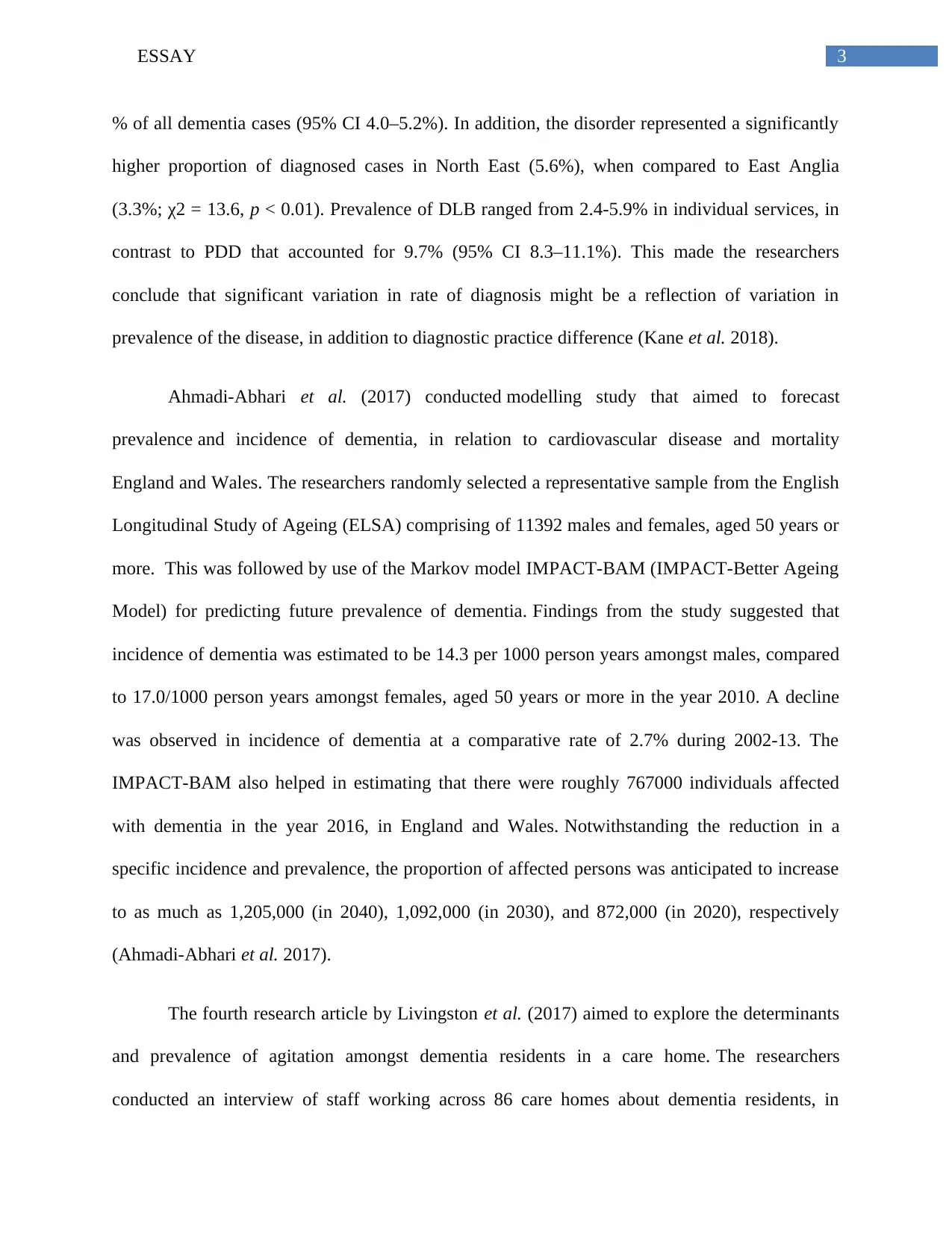
3ESSAY
% of all dementia cases (95% CI 4.0–5.2%). In addition, the disorder represented a significantly
higher proportion of diagnosed cases in North East (5.6%), when compared to East Anglia
(3.3%; χ2 = 13.6, p < 0.01). Prevalence of DLB ranged from 2.4-5.9% in individual services, in
contrast to PDD that accounted for 9.7% (95% CI 8.3–11.1%). This made the researchers
conclude that significant variation in rate of diagnosis might be a reflection of variation in
prevalence of the disease, in addition to diagnostic practice difference (Kane et al. 2018).
Ahmadi-Abhari et al. (2017) conducted modelling study that aimed to forecast
prevalence and incidence of dementia, in relation to cardiovascular disease and mortality
England and Wales. The researchers randomly selected a representative sample from the English
Longitudinal Study of Ageing (ELSA) comprising of 11392 males and females, aged 50 years or
more. This was followed by use of the Markov model IMPACT-BAM (IMPACT-Better Ageing
Model) for predicting future prevalence of dementia. Findings from the study suggested that
incidence of dementia was estimated to be 14.3 per 1000 person years amongst males, compared
to 17.0/1000 person years amongst females, aged 50 years or more in the year 2010. A decline
was observed in incidence of dementia at a comparative rate of 2.7% during 2002-13. The
IMPACT-BAM also helped in estimating that there were roughly 767000 individuals affected
with dementia in the year 2016, in England and Wales. Notwithstanding the reduction in a
specific incidence and prevalence, the proportion of affected persons was anticipated to increase
to as much as 1,205,000 (in 2040), 1,092,000 (in 2030), and 872,000 (in 2020), respectively
(Ahmadi-Abhari et al. 2017).
The fourth research article by Livingston et al. (2017) aimed to explore the determinants
and prevalence of agitation amongst dementia residents in a care home. The researchers
conducted an interview of staff working across 86 care homes about dementia residents, in
% of all dementia cases (95% CI 4.0–5.2%). In addition, the disorder represented a significantly
higher proportion of diagnosed cases in North East (5.6%), when compared to East Anglia
(3.3%; χ2 = 13.6, p < 0.01). Prevalence of DLB ranged from 2.4-5.9% in individual services, in
contrast to PDD that accounted for 9.7% (95% CI 8.3–11.1%). This made the researchers
conclude that significant variation in rate of diagnosis might be a reflection of variation in
prevalence of the disease, in addition to diagnostic practice difference (Kane et al. 2018).
Ahmadi-Abhari et al. (2017) conducted modelling study that aimed to forecast
prevalence and incidence of dementia, in relation to cardiovascular disease and mortality
England and Wales. The researchers randomly selected a representative sample from the English
Longitudinal Study of Ageing (ELSA) comprising of 11392 males and females, aged 50 years or
more. This was followed by use of the Markov model IMPACT-BAM (IMPACT-Better Ageing
Model) for predicting future prevalence of dementia. Findings from the study suggested that
incidence of dementia was estimated to be 14.3 per 1000 person years amongst males, compared
to 17.0/1000 person years amongst females, aged 50 years or more in the year 2010. A decline
was observed in incidence of dementia at a comparative rate of 2.7% during 2002-13. The
IMPACT-BAM also helped in estimating that there were roughly 767000 individuals affected
with dementia in the year 2016, in England and Wales. Notwithstanding the reduction in a
specific incidence and prevalence, the proportion of affected persons was anticipated to increase
to as much as 1,205,000 (in 2040), 1,092,000 (in 2030), and 872,000 (in 2020), respectively
(Ahmadi-Abhari et al. 2017).
The fourth research article by Livingston et al. (2017) aimed to explore the determinants
and prevalence of agitation amongst dementia residents in a care home. The researchers
conducted an interview of staff working across 86 care homes about dementia residents, in
Paraphrase This Document
Need a fresh take? Get an instant paraphrase of this document with our AI Paraphraser
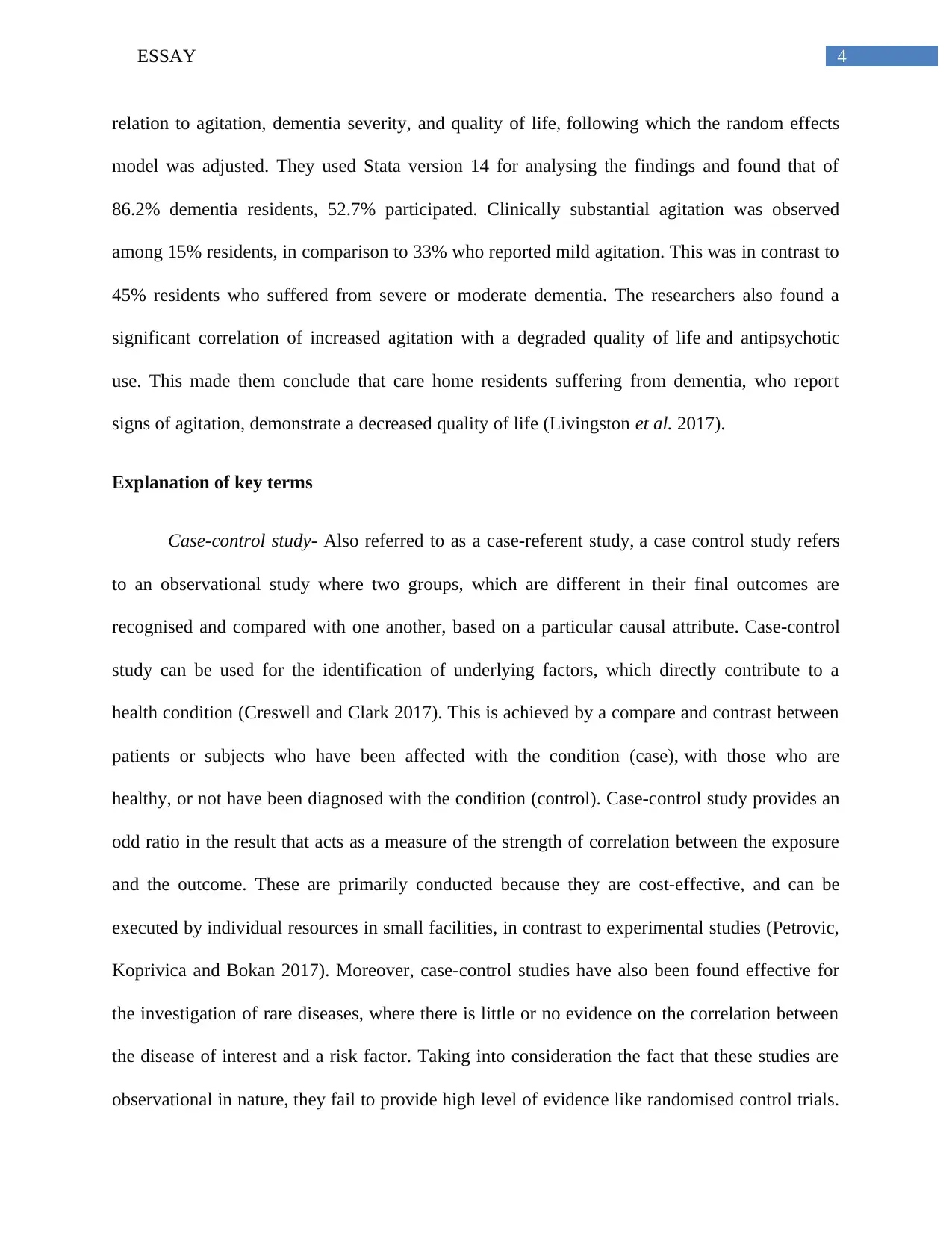
4ESSAY
relation to agitation, dementia severity, and quality of life, following which the random effects
model was adjusted. They used Stata version 14 for analysing the findings and found that of
86.2% dementia residents, 52.7% participated. Clinically substantial agitation was observed
among 15% residents, in comparison to 33% who reported mild agitation. This was in contrast to
45% residents who suffered from severe or moderate dementia. The researchers also found a
significant correlation of increased agitation with a degraded quality of life and antipsychotic
use. This made them conclude that care home residents suffering from dementia, who report
signs of agitation, demonstrate a decreased quality of life (Livingston et al. 2017).
Explanation of key terms
Case-control study- Also referred to as a case-referent study, a case control study refers
to an observational study where two groups, which are different in their final outcomes are
recognised and compared with one another, based on a particular causal attribute. Case-control
study can be used for the identification of underlying factors, which directly contribute to a
health condition (Creswell and Clark 2017). This is achieved by a compare and contrast between
patients or subjects who have been affected with the condition (case), with those who are
healthy, or not have been diagnosed with the condition (control). Case-control study provides an
odd ratio in the result that acts as a measure of the strength of correlation between the exposure
and the outcome. These are primarily conducted because they are cost-effective, and can be
executed by individual resources in small facilities, in contrast to experimental studies (Petrovic,
Koprivica and Bokan 2017). Moreover, case-control studies have also been found effective for
the investigation of rare diseases, where there is little or no evidence on the correlation between
the disease of interest and a risk factor. Taking into consideration the fact that these studies are
observational in nature, they fail to provide high level of evidence like randomised control trials.
relation to agitation, dementia severity, and quality of life, following which the random effects
model was adjusted. They used Stata version 14 for analysing the findings and found that of
86.2% dementia residents, 52.7% participated. Clinically substantial agitation was observed
among 15% residents, in comparison to 33% who reported mild agitation. This was in contrast to
45% residents who suffered from severe or moderate dementia. The researchers also found a
significant correlation of increased agitation with a degraded quality of life and antipsychotic
use. This made them conclude that care home residents suffering from dementia, who report
signs of agitation, demonstrate a decreased quality of life (Livingston et al. 2017).
Explanation of key terms
Case-control study- Also referred to as a case-referent study, a case control study refers
to an observational study where two groups, which are different in their final outcomes are
recognised and compared with one another, based on a particular causal attribute. Case-control
study can be used for the identification of underlying factors, which directly contribute to a
health condition (Creswell and Clark 2017). This is achieved by a compare and contrast between
patients or subjects who have been affected with the condition (case), with those who are
healthy, or not have been diagnosed with the condition (control). Case-control study provides an
odd ratio in the result that acts as a measure of the strength of correlation between the exposure
and the outcome. These are primarily conducted because they are cost-effective, and can be
executed by individual resources in small facilities, in contrast to experimental studies (Petrovic,
Koprivica and Bokan 2017). Moreover, case-control studies have also been found effective for
the investigation of rare diseases, where there is little or no evidence on the correlation between
the disease of interest and a risk factor. Taking into consideration the fact that these studies are
observational in nature, they fail to provide high level of evidence like randomised control trials.
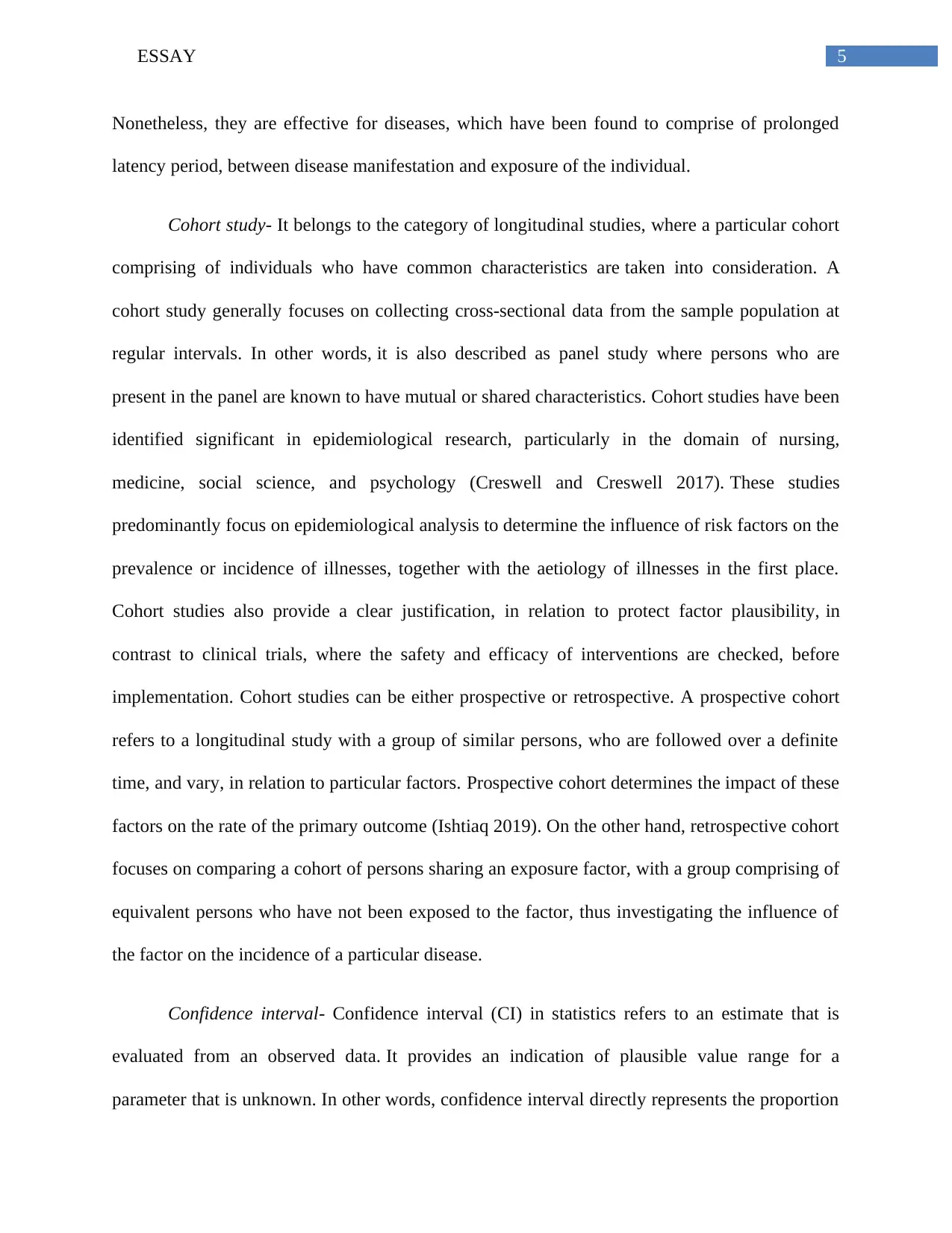
5ESSAY
Nonetheless, they are effective for diseases, which have been found to comprise of prolonged
latency period, between disease manifestation and exposure of the individual.
Cohort study- It belongs to the category of longitudinal studies, where a particular cohort
comprising of individuals who have common characteristics are taken into consideration. A
cohort study generally focuses on collecting cross-sectional data from the sample population at
regular intervals. In other words, it is also described as panel study where persons who are
present in the panel are known to have mutual or shared characteristics. Cohort studies have been
identified significant in epidemiological research, particularly in the domain of nursing,
medicine, social science, and psychology (Creswell and Creswell 2017). These studies
predominantly focus on epidemiological analysis to determine the influence of risk factors on the
prevalence or incidence of illnesses, together with the aetiology of illnesses in the first place.
Cohort studies also provide a clear justification, in relation to protect factor plausibility, in
contrast to clinical trials, where the safety and efficacy of interventions are checked, before
implementation. Cohort studies can be either prospective or retrospective. A prospective cohort
refers to a longitudinal study with a group of similar persons, who are followed over a definite
time, and vary, in relation to particular factors. Prospective cohort determines the impact of these
factors on the rate of the primary outcome (Ishtiaq 2019). On the other hand, retrospective cohort
focuses on comparing a cohort of persons sharing an exposure factor, with a group comprising of
equivalent persons who have not been exposed to the factor, thus investigating the influence of
the factor on the incidence of a particular disease.
Confidence interval- Confidence interval (CI) in statistics refers to an estimate that is
evaluated from an observed data. It provides an indication of plausible value range for a
parameter that is unknown. In other words, confidence interval directly represents the proportion
Nonetheless, they are effective for diseases, which have been found to comprise of prolonged
latency period, between disease manifestation and exposure of the individual.
Cohort study- It belongs to the category of longitudinal studies, where a particular cohort
comprising of individuals who have common characteristics are taken into consideration. A
cohort study generally focuses on collecting cross-sectional data from the sample population at
regular intervals. In other words, it is also described as panel study where persons who are
present in the panel are known to have mutual or shared characteristics. Cohort studies have been
identified significant in epidemiological research, particularly in the domain of nursing,
medicine, social science, and psychology (Creswell and Creswell 2017). These studies
predominantly focus on epidemiological analysis to determine the influence of risk factors on the
prevalence or incidence of illnesses, together with the aetiology of illnesses in the first place.
Cohort studies also provide a clear justification, in relation to protect factor plausibility, in
contrast to clinical trials, where the safety and efficacy of interventions are checked, before
implementation. Cohort studies can be either prospective or retrospective. A prospective cohort
refers to a longitudinal study with a group of similar persons, who are followed over a definite
time, and vary, in relation to particular factors. Prospective cohort determines the impact of these
factors on the rate of the primary outcome (Ishtiaq 2019). On the other hand, retrospective cohort
focuses on comparing a cohort of persons sharing an exposure factor, with a group comprising of
equivalent persons who have not been exposed to the factor, thus investigating the influence of
the factor on the incidence of a particular disease.
Confidence interval- Confidence interval (CI) in statistics refers to an estimate that is
evaluated from an observed data. It provides an indication of plausible value range for a
parameter that is unknown. In other words, confidence interval directly represents the proportion
⊘ This is a preview!⊘
Do you want full access?
Subscribe today to unlock all pages.

Trusted by 1+ million students worldwide
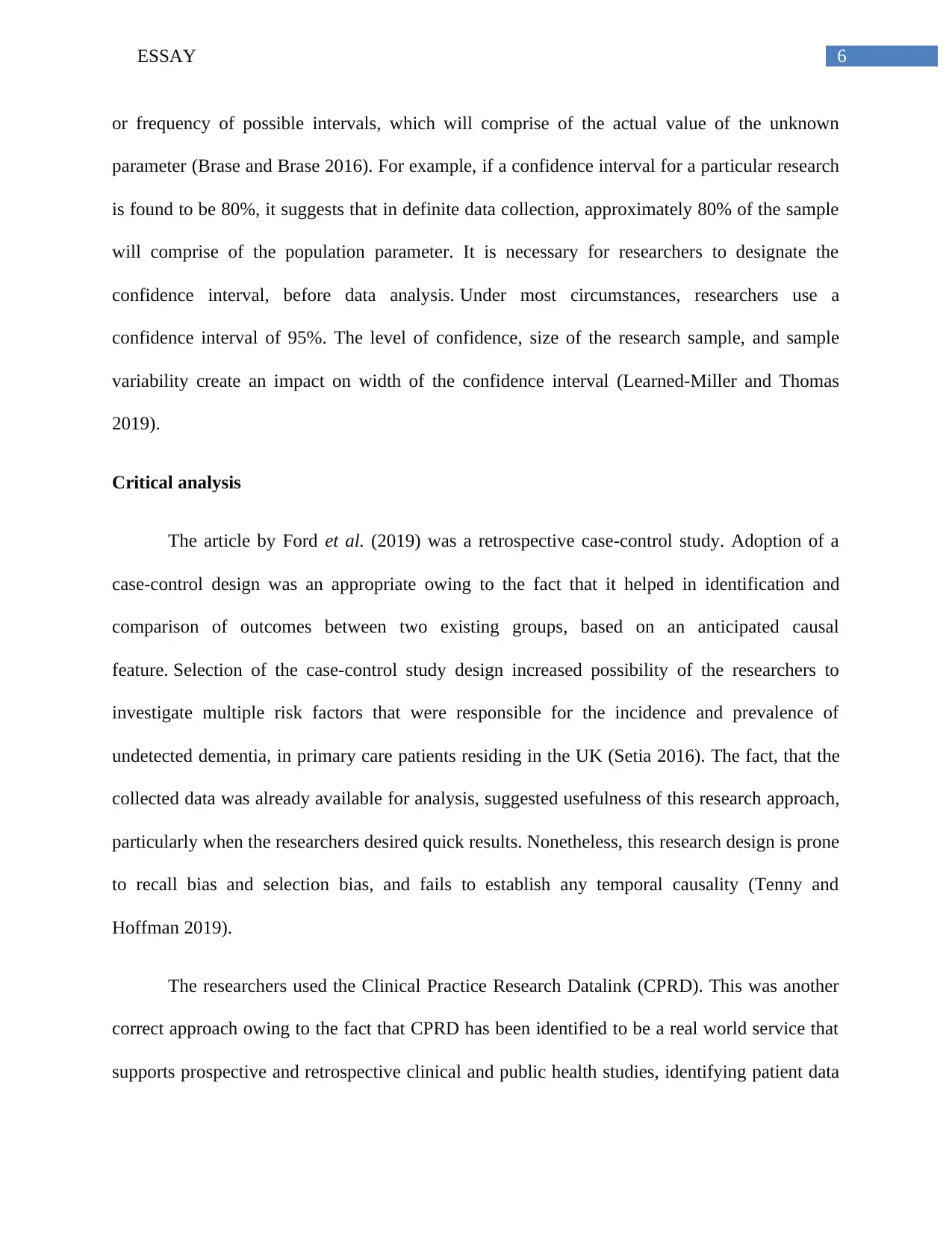
6ESSAY
or frequency of possible intervals, which will comprise of the actual value of the unknown
parameter (Brase and Brase 2016). For example, if a confidence interval for a particular research
is found to be 80%, it suggests that in definite data collection, approximately 80% of the sample
will comprise of the population parameter. It is necessary for researchers to designate the
confidence interval, before data analysis. Under most circumstances, researchers use a
confidence interval of 95%. The level of confidence, size of the research sample, and sample
variability create an impact on width of the confidence interval (Learned-Miller and Thomas
2019).
Critical analysis
The article by Ford et al. (2019) was a retrospective case-control study. Adoption of a
case-control design was an appropriate owing to the fact that it helped in identification and
comparison of outcomes between two existing groups, based on an anticipated causal
feature. Selection of the case-control study design increased possibility of the researchers to
investigate multiple risk factors that were responsible for the incidence and prevalence of
undetected dementia, in primary care patients residing in the UK (Setia 2016). The fact, that the
collected data was already available for analysis, suggested usefulness of this research approach,
particularly when the researchers desired quick results. Nonetheless, this research design is prone
to recall bias and selection bias, and fails to establish any temporal causality (Tenny and
Hoffman 2019).
The researchers used the Clinical Practice Research Datalink (CPRD). This was another
correct approach owing to the fact that CPRD has been identified to be a real world service that
supports prospective and retrospective clinical and public health studies, identifying patient data
or frequency of possible intervals, which will comprise of the actual value of the unknown
parameter (Brase and Brase 2016). For example, if a confidence interval for a particular research
is found to be 80%, it suggests that in definite data collection, approximately 80% of the sample
will comprise of the population parameter. It is necessary for researchers to designate the
confidence interval, before data analysis. Under most circumstances, researchers use a
confidence interval of 95%. The level of confidence, size of the research sample, and sample
variability create an impact on width of the confidence interval (Learned-Miller and Thomas
2019).
Critical analysis
The article by Ford et al. (2019) was a retrospective case-control study. Adoption of a
case-control design was an appropriate owing to the fact that it helped in identification and
comparison of outcomes between two existing groups, based on an anticipated causal
feature. Selection of the case-control study design increased possibility of the researchers to
investigate multiple risk factors that were responsible for the incidence and prevalence of
undetected dementia, in primary care patients residing in the UK (Setia 2016). The fact, that the
collected data was already available for analysis, suggested usefulness of this research approach,
particularly when the researchers desired quick results. Nonetheless, this research design is prone
to recall bias and selection bias, and fails to establish any temporal causality (Tenny and
Hoffman 2019).
The researchers used the Clinical Practice Research Datalink (CPRD). This was another
correct approach owing to the fact that CPRD has been identified to be a real world service that
supports prospective and retrospective clinical and public health studies, identifying patient data
Paraphrase This Document
Need a fresh take? Get an instant paraphrase of this document with our AI Paraphraser
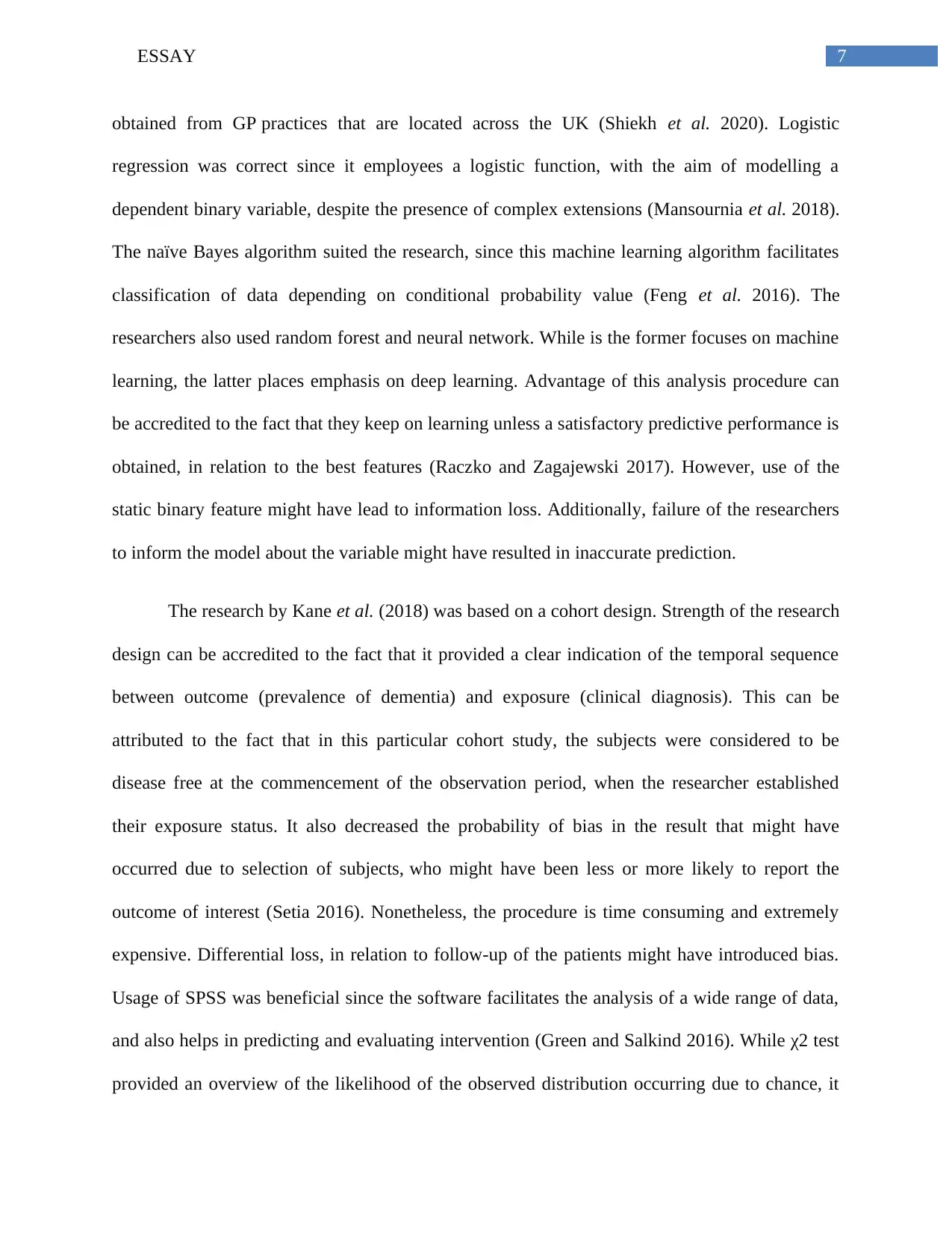
7ESSAY
obtained from GP practices that are located across the UK (Shiekh et al. 2020). Logistic
regression was correct since it employees a logistic function, with the aim of modelling a
dependent binary variable, despite the presence of complex extensions (Mansournia et al. 2018).
The naïve Bayes algorithm suited the research, since this machine learning algorithm facilitates
classification of data depending on conditional probability value (Feng et al. 2016). The
researchers also used random forest and neural network. While is the former focuses on machine
learning, the latter places emphasis on deep learning. Advantage of this analysis procedure can
be accredited to the fact that they keep on learning unless a satisfactory predictive performance is
obtained, in relation to the best features (Raczko and Zagajewski 2017). However, use of the
static binary feature might have lead to information loss. Additionally, failure of the researchers
to inform the model about the variable might have resulted in inaccurate prediction.
The research by Kane et al. (2018) was based on a cohort design. Strength of the research
design can be accredited to the fact that it provided a clear indication of the temporal sequence
between outcome (prevalence of dementia) and exposure (clinical diagnosis). This can be
attributed to the fact that in this particular cohort study, the subjects were considered to be
disease free at the commencement of the observation period, when the researcher established
their exposure status. It also decreased the probability of bias in the result that might have
occurred due to selection of subjects, who might have been less or more likely to report the
outcome of interest (Setia 2016). Nonetheless, the procedure is time consuming and extremely
expensive. Differential loss, in relation to follow-up of the patients might have introduced bias.
Usage of SPSS was beneficial since the software facilitates the analysis of a wide range of data,
and also helps in predicting and evaluating intervention (Green and Salkind 2016). While χ2 test
provided an overview of the likelihood of the observed distribution occurring due to chance, it
obtained from GP practices that are located across the UK (Shiekh et al. 2020). Logistic
regression was correct since it employees a logistic function, with the aim of modelling a
dependent binary variable, despite the presence of complex extensions (Mansournia et al. 2018).
The naïve Bayes algorithm suited the research, since this machine learning algorithm facilitates
classification of data depending on conditional probability value (Feng et al. 2016). The
researchers also used random forest and neural network. While is the former focuses on machine
learning, the latter places emphasis on deep learning. Advantage of this analysis procedure can
be accredited to the fact that they keep on learning unless a satisfactory predictive performance is
obtained, in relation to the best features (Raczko and Zagajewski 2017). However, use of the
static binary feature might have lead to information loss. Additionally, failure of the researchers
to inform the model about the variable might have resulted in inaccurate prediction.
The research by Kane et al. (2018) was based on a cohort design. Strength of the research
design can be accredited to the fact that it provided a clear indication of the temporal sequence
between outcome (prevalence of dementia) and exposure (clinical diagnosis). This can be
attributed to the fact that in this particular cohort study, the subjects were considered to be
disease free at the commencement of the observation period, when the researcher established
their exposure status. It also decreased the probability of bias in the result that might have
occurred due to selection of subjects, who might have been less or more likely to report the
outcome of interest (Setia 2016). Nonetheless, the procedure is time consuming and extremely
expensive. Differential loss, in relation to follow-up of the patients might have introduced bias.
Usage of SPSS was beneficial since the software facilitates the analysis of a wide range of data,
and also helps in predicting and evaluating intervention (Green and Salkind 2016). While χ2 test
provided an overview of the likelihood of the observed distribution occurring due to chance, it
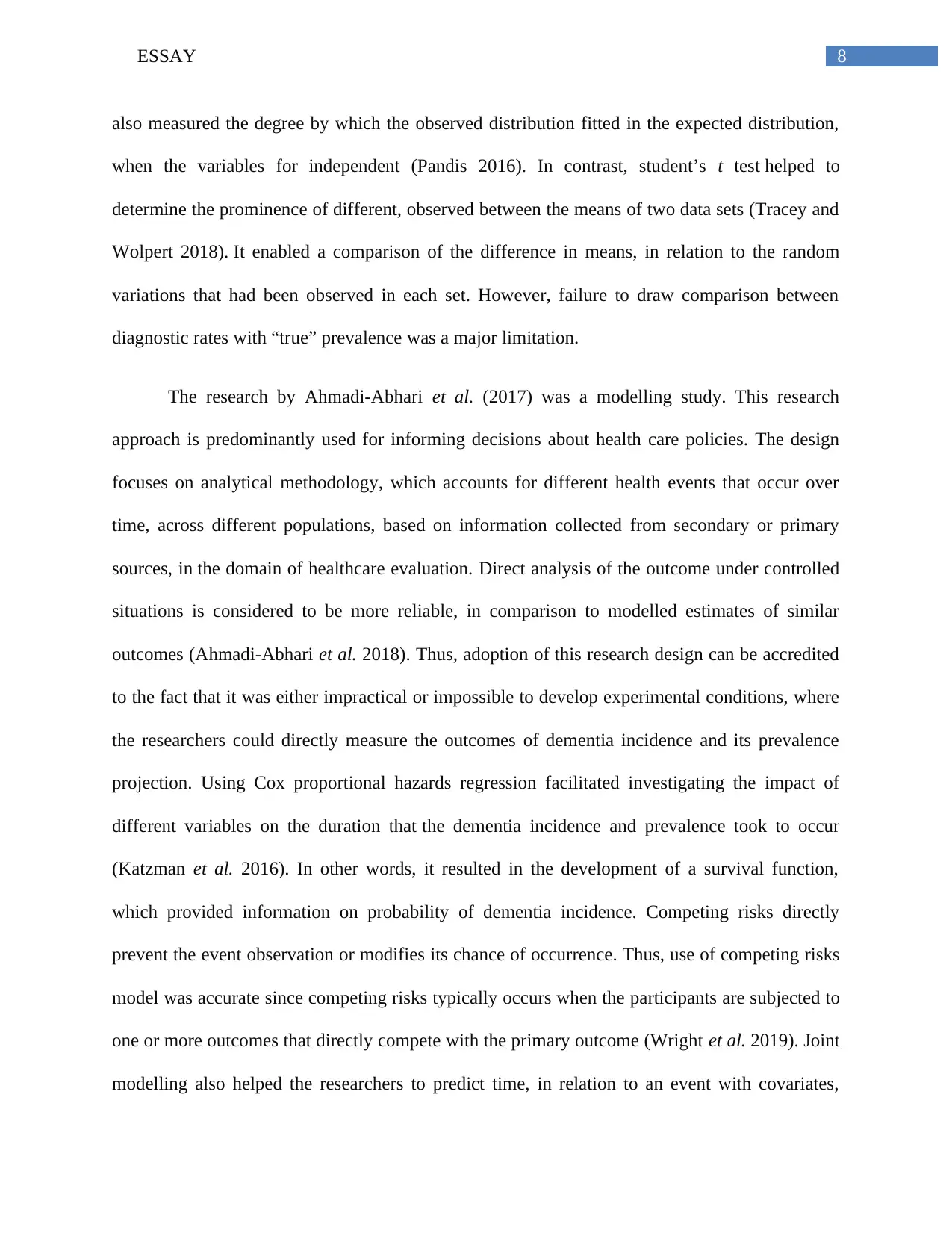
8ESSAY
also measured the degree by which the observed distribution fitted in the expected distribution,
when the variables for independent (Pandis 2016). In contrast, student’s t test helped to
determine the prominence of different, observed between the means of two data sets (Tracey and
Wolpert 2018). It enabled a comparison of the difference in means, in relation to the random
variations that had been observed in each set. However, failure to draw comparison between
diagnostic rates with “true” prevalence was a major limitation.
The research by Ahmadi-Abhari et al. (2017) was a modelling study. This research
approach is predominantly used for informing decisions about health care policies. The design
focuses on analytical methodology, which accounts for different health events that occur over
time, across different populations, based on information collected from secondary or primary
sources, in the domain of healthcare evaluation. Direct analysis of the outcome under controlled
situations is considered to be more reliable, in comparison to modelled estimates of similar
outcomes (Ahmadi-Abhari et al. 2018). Thus, adoption of this research design can be accredited
to the fact that it was either impractical or impossible to develop experimental conditions, where
the researchers could directly measure the outcomes of dementia incidence and its prevalence
projection. Using Cox proportional hazards regression facilitated investigating the impact of
different variables on the duration that the dementia incidence and prevalence took to occur
(Katzman et al. 2016). In other words, it resulted in the development of a survival function,
which provided information on probability of dementia incidence. Competing risks directly
prevent the event observation or modifies its chance of occurrence. Thus, use of competing risks
model was accurate since competing risks typically occurs when the participants are subjected to
one or more outcomes that directly compete with the primary outcome (Wright et al. 2019). Joint
modelling also helped the researchers to predict time, in relation to an event with covariates,
also measured the degree by which the observed distribution fitted in the expected distribution,
when the variables for independent (Pandis 2016). In contrast, student’s t test helped to
determine the prominence of different, observed between the means of two data sets (Tracey and
Wolpert 2018). It enabled a comparison of the difference in means, in relation to the random
variations that had been observed in each set. However, failure to draw comparison between
diagnostic rates with “true” prevalence was a major limitation.
The research by Ahmadi-Abhari et al. (2017) was a modelling study. This research
approach is predominantly used for informing decisions about health care policies. The design
focuses on analytical methodology, which accounts for different health events that occur over
time, across different populations, based on information collected from secondary or primary
sources, in the domain of healthcare evaluation. Direct analysis of the outcome under controlled
situations is considered to be more reliable, in comparison to modelled estimates of similar
outcomes (Ahmadi-Abhari et al. 2018). Thus, adoption of this research design can be accredited
to the fact that it was either impractical or impossible to develop experimental conditions, where
the researchers could directly measure the outcomes of dementia incidence and its prevalence
projection. Using Cox proportional hazards regression facilitated investigating the impact of
different variables on the duration that the dementia incidence and prevalence took to occur
(Katzman et al. 2016). In other words, it resulted in the development of a survival function,
which provided information on probability of dementia incidence. Competing risks directly
prevent the event observation or modifies its chance of occurrence. Thus, use of competing risks
model was accurate since competing risks typically occurs when the participants are subjected to
one or more outcomes that directly compete with the primary outcome (Wright et al. 2019). Joint
modelling also helped the researchers to predict time, in relation to an event with covariates,
⊘ This is a preview!⊘
Do you want full access?
Subscribe today to unlock all pages.

Trusted by 1+ million students worldwide
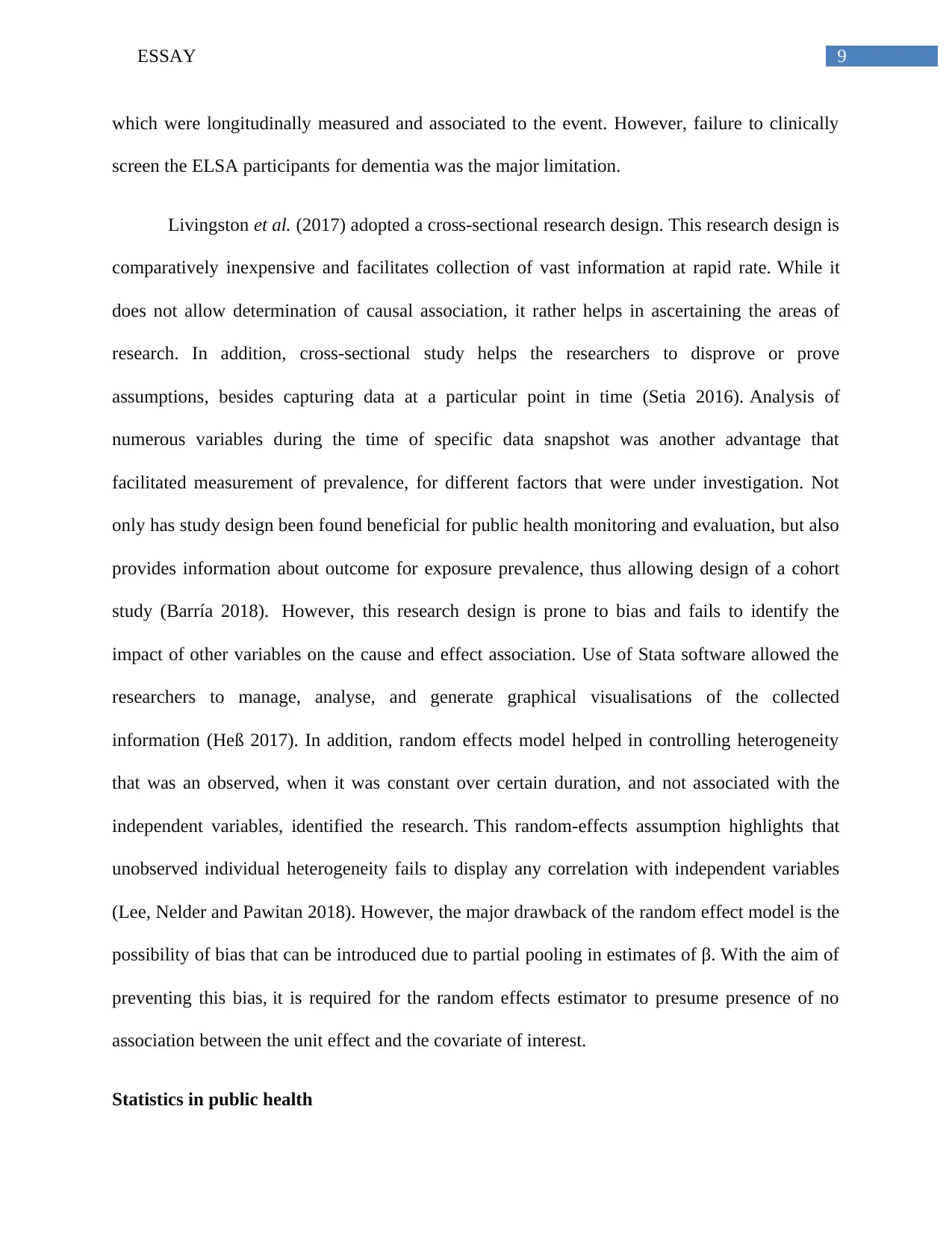
9ESSAY
which were longitudinally measured and associated to the event. However, failure to clinically
screen the ELSA participants for dementia was the major limitation.
Livingston et al. (2017) adopted a cross-sectional research design. This research design is
comparatively inexpensive and facilitates collection of vast information at rapid rate. While it
does not allow determination of causal association, it rather helps in ascertaining the areas of
research. In addition, cross-sectional study helps the researchers to disprove or prove
assumptions, besides capturing data at a particular point in time (Setia 2016). Analysis of
numerous variables during the time of specific data snapshot was another advantage that
facilitated measurement of prevalence, for different factors that were under investigation. Not
only has study design been found beneficial for public health monitoring and evaluation, but also
provides information about outcome for exposure prevalence, thus allowing design of a cohort
study (Barría 2018). However, this research design is prone to bias and fails to identify the
impact of other variables on the cause and effect association. Use of Stata software allowed the
researchers to manage, analyse, and generate graphical visualisations of the collected
information (Heß 2017). In addition, random effects model helped in controlling heterogeneity
that was an observed, when it was constant over certain duration, and not associated with the
independent variables, identified the research. This random-effects assumption highlights that
unobserved individual heterogeneity fails to display any correlation with independent variables
(Lee, Nelder and Pawitan 2018). However, the major drawback of the random effect model is the
possibility of bias that can be introduced due to partial pooling in estimates of β. With the aim of
preventing this bias, it is required for the random effects estimator to presume presence of no
association between the unit effect and the covariate of interest.
Statistics in public health
which were longitudinally measured and associated to the event. However, failure to clinically
screen the ELSA participants for dementia was the major limitation.
Livingston et al. (2017) adopted a cross-sectional research design. This research design is
comparatively inexpensive and facilitates collection of vast information at rapid rate. While it
does not allow determination of causal association, it rather helps in ascertaining the areas of
research. In addition, cross-sectional study helps the researchers to disprove or prove
assumptions, besides capturing data at a particular point in time (Setia 2016). Analysis of
numerous variables during the time of specific data snapshot was another advantage that
facilitated measurement of prevalence, for different factors that were under investigation. Not
only has study design been found beneficial for public health monitoring and evaluation, but also
provides information about outcome for exposure prevalence, thus allowing design of a cohort
study (Barría 2018). However, this research design is prone to bias and fails to identify the
impact of other variables on the cause and effect association. Use of Stata software allowed the
researchers to manage, analyse, and generate graphical visualisations of the collected
information (Heß 2017). In addition, random effects model helped in controlling heterogeneity
that was an observed, when it was constant over certain duration, and not associated with the
independent variables, identified the research. This random-effects assumption highlights that
unobserved individual heterogeneity fails to display any correlation with independent variables
(Lee, Nelder and Pawitan 2018). However, the major drawback of the random effect model is the
possibility of bias that can be introduced due to partial pooling in estimates of β. With the aim of
preventing this bias, it is required for the random effects estimator to presume presence of no
association between the unit effect and the covariate of interest.
Statistics in public health
Paraphrase This Document
Need a fresh take? Get an instant paraphrase of this document with our AI Paraphraser
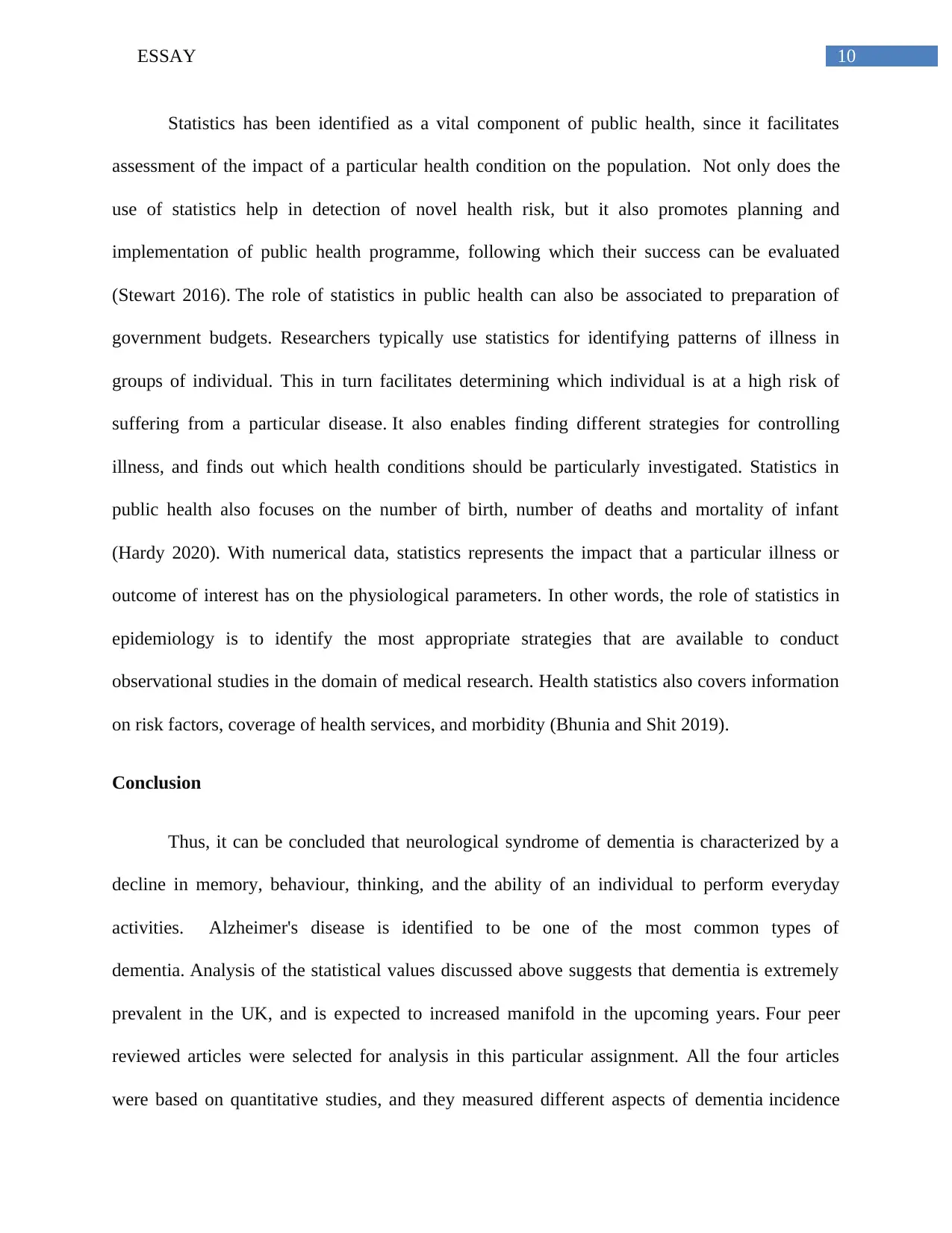
10ESSAY
Statistics has been identified as a vital component of public health, since it facilitates
assessment of the impact of a particular health condition on the population. Not only does the
use of statistics help in detection of novel health risk, but it also promotes planning and
implementation of public health programme, following which their success can be evaluated
(Stewart 2016). The role of statistics in public health can also be associated to preparation of
government budgets. Researchers typically use statistics for identifying patterns of illness in
groups of individual. This in turn facilitates determining which individual is at a high risk of
suffering from a particular disease. It also enables finding different strategies for controlling
illness, and finds out which health conditions should be particularly investigated. Statistics in
public health also focuses on the number of birth, number of deaths and mortality of infant
(Hardy 2020). With numerical data, statistics represents the impact that a particular illness or
outcome of interest has on the physiological parameters. In other words, the role of statistics in
epidemiology is to identify the most appropriate strategies that are available to conduct
observational studies in the domain of medical research. Health statistics also covers information
on risk factors, coverage of health services, and morbidity (Bhunia and Shit 2019).
Conclusion
Thus, it can be concluded that neurological syndrome of dementia is characterized by a
decline in memory, behaviour, thinking, and the ability of an individual to perform everyday
activities. Alzheimer's disease is identified to be one of the most common types of
dementia. Analysis of the statistical values discussed above suggests that dementia is extremely
prevalent in the UK, and is expected to increased manifold in the upcoming years. Four peer
reviewed articles were selected for analysis in this particular assignment. All the four articles
were based on quantitative studies, and they measured different aspects of dementia incidence
Statistics has been identified as a vital component of public health, since it facilitates
assessment of the impact of a particular health condition on the population. Not only does the
use of statistics help in detection of novel health risk, but it also promotes planning and
implementation of public health programme, following which their success can be evaluated
(Stewart 2016). The role of statistics in public health can also be associated to preparation of
government budgets. Researchers typically use statistics for identifying patterns of illness in
groups of individual. This in turn facilitates determining which individual is at a high risk of
suffering from a particular disease. It also enables finding different strategies for controlling
illness, and finds out which health conditions should be particularly investigated. Statistics in
public health also focuses on the number of birth, number of deaths and mortality of infant
(Hardy 2020). With numerical data, statistics represents the impact that a particular illness or
outcome of interest has on the physiological parameters. In other words, the role of statistics in
epidemiology is to identify the most appropriate strategies that are available to conduct
observational studies in the domain of medical research. Health statistics also covers information
on risk factors, coverage of health services, and morbidity (Bhunia and Shit 2019).
Conclusion
Thus, it can be concluded that neurological syndrome of dementia is characterized by a
decline in memory, behaviour, thinking, and the ability of an individual to perform everyday
activities. Alzheimer's disease is identified to be one of the most common types of
dementia. Analysis of the statistical values discussed above suggests that dementia is extremely
prevalent in the UK, and is expected to increased manifold in the upcoming years. Four peer
reviewed articles were selected for analysis in this particular assignment. All the four articles
were based on quantitative studies, and they measured different aspects of dementia incidence

11ESSAY
and prevalence. While one was based on a case-control study, another article was a cohort study.
The third and fourth articles were modelling study and cross-sectional study, respectively.
Statistics in public health is a significant since it facilitates analysing the validity of claims
associated to factors, which create an impact on health. Each of the four articles employed
different statistical analysis for calculating the primary and secondary outcomes. Use of statistics
in the topic of public health not only facilitated determining the pervasiveness and incidence of
dementia in the UK population, but also helped to identify individuals who were at risk of
suffering from the disorder.
and prevalence. While one was based on a case-control study, another article was a cohort study.
The third and fourth articles were modelling study and cross-sectional study, respectively.
Statistics in public health is a significant since it facilitates analysing the validity of claims
associated to factors, which create an impact on health. Each of the four articles employed
different statistical analysis for calculating the primary and secondary outcomes. Use of statistics
in the topic of public health not only facilitated determining the pervasiveness and incidence of
dementia in the UK population, but also helped to identify individuals who were at risk of
suffering from the disorder.
⊘ This is a preview!⊘
Do you want full access?
Subscribe today to unlock all pages.

Trusted by 1+ million students worldwide
1 out of 17
Related Documents
Your All-in-One AI-Powered Toolkit for Academic Success.
+13062052269
info@desklib.com
Available 24*7 on WhatsApp / Email
![[object Object]](/_next/static/media/star-bottom.7253800d.svg)
Unlock your academic potential
Copyright © 2020–2025 A2Z Services. All Rights Reserved. Developed and managed by ZUCOL.





